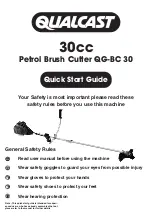
FR 131 T
English
7
When mowing in high shrubbery, under
shrubbery and hedges: Hold the cutting
tool at a working height of at least 15 cm
– avoid risks to animals.
Before you leave the machine: Shut the
engine off.
Examine the cutting attachment
periodically at short intervals and as
soon as you note any noticeable
changes:
–
Stop the engine, hold the machine
securely, allow the cutting
attachment to come to a stop
–
Check condition and secure fitting;
watch out for cracks
–
Ensure that the cutting blades are
sharp
–
Replace damaged or dull cutting
attachments immediately, even if
they have only superficial cracks
Clean grass and plant residue off the
cutting attachment mounting at regular
intervals – remove any build up of
material from the cutting attachment and
deflector.
To reduce the risk of injury, shut off the
engine before replacing the cutting
attachment.
Using mowing heads
Enhance the cutting attachment
deflector with the attached parts
specified in the User Manual.
Only use the protection with properly
mounted blade to ensure that the
mowing line is restricted to the
permissible length.
Always switch off the engine to adjust
the mowing line for manually adjustable
mowing heads – risk of injury!
Misuse with mowing lines that are too
long reduces the working speed of the
engine. The constant slipping of the
clutch causes overheating and damage
to important components (e. g. clutch,
plastic housing parts) – e. g. due to the
cutting attachment rotating during idling
– risk of injury!
When using metal cutting attachments
STIHL recommends the use of original
STIHL metal cutting attachments. These
have been optimized for the machine
and the user’s requirements.
Metal cutting attachments rotate very
fast, generating forces acting on the
attachments and on the cuttings.
Metal cutting attachments must be
sharpened in regular intervals in
accordance with the instructions.
Unevenly sharpened metal cutting
attachments generate an imbalance
which may cause extreme loads on the
machine – risk of breakage!
Dull or improperly sharpened cutting
edges can put a higher load on the
cutting attachment and increase the risk
of injuryfrom cracked or broken parts.
After each contact of the metal cutting
attachment with hard objects (e.g.
stones, rocks, metal parts), check it for
damage (e.g. tears and deformation). To
reduce the risk of injury, remove burrs
and other visible build-ups of material
because they may become detached
and be thrown at high speed during
operation.
If a rotating metal cutting attachment
touches a rock or another hard object,
sparks may be generated which may
possibly ignite combustible materials.
Also dried-out plants and brushwood are
combustible, above all in hot and dry
weather. If there is a risk of fire, do not
use metal cutting attachments in the
vicinity of combustible materials, dried-
out plants or brushwood. It is mandatory
that you ask the responsible forestry
office about the current fire hazard.
Do not continue using or attempt to
repair damaged or cracked cutting
attachments by welding, straightening or
modifying the shape (out of balance).
Particles or pieces may come off and hit
the operator or a bystander at a high
speed – risk of most severe injuries!
To reduce the above-named risks
involved in operating a metal cutting
attachment, ensure that the diameter of
your metal cutting attachment is not too
big. Also, the attachment must not be
too heavy. It must be made of high-
quality materials and have a suitable
geometry (shape, thickness).
To reduce the risk of injury, a metal
cutting attachment not manufactured by
STIHL must not be heavier, thicker,
have a different shape or a diameter
larger than the largest metal cutting
attachment approved by STIHL for this
power tool model.
The gearbox gets hot
during operation. Never
touch the gearbox – risk
of burns!
Содержание FR 131 T
Страница 1: ...STIHL FR 131 T Instruction Manual ...
Страница 2: ......
Страница 43: ......
Страница 44: ...www stihl com 04584340121A 0458 434 0121 A 0458 434 0121 A englisch G ...










































